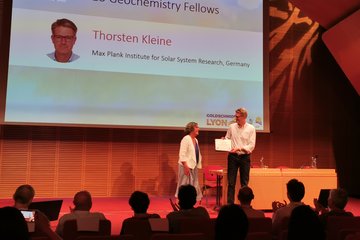Alle Typen
101.
Zeitschriftenartikel
Helium line formation and abundance in a solar active region. Astrophysical Journal 619, S. 604 - 612 (2005)
102.
Zeitschriftenartikel
Using LASCO-C1 spectroscopy for coronal diagnostics. Advances in Space Research 35, S. 2199 - 2203 (2005)
103.
Zeitschriftenartikel
Dynamics of the Solar Corona Using LASCO-C1 Spectral Data. Romanian Astronomical Journal 1, S. 137 (2005)
104.
Zeitschriftenartikel
The widths of vacuum-ultraviolet spectral lines in the equatorial solar corona observed with CDS and SUMER. Astronomy and Astrophysics 435, S. 733 - 741 (2005)
105.
Zeitschriftenartikel
Transition region small-scale dynamics as seen by SUMER on SOHO. Astronomy and Astrophysics 427, S. 1065 - 1074 (2004)
106.
Zeitschriftenartikel
On the widths of the Mg X lines near 60 nm in the corona. Astronomy and Astrophysics 415, S. 1133 - 1139 (2004)
107.
Zeitschriftenartikel
Behaviour of Hydrogen Lyman lines in a prominence region from SUMER and CDS. Memorie della Societa Astronomica Italiana 74, S. 611 (2003)
108.
Zeitschriftenartikel
Solar and heliospheric observatory/coronal diagnostic spectrograph and ground-based observations of a two-ribbon flare: Spatially resolved signatures of chromospheric evaporation. Astrophysical Journal 588, S. 596 - 605 (2003)
109.
Zeitschriftenartikel
The nascent solar wind: Origin and acceleration. Astrophysical Journal 588, S. 566 - 577 (2003)
110.
Zeitschriftenartikel
Broadening of Si VIII lines observed in the solar polar coronal holes. Astronomy and Astrophysics 339, S. 208 - 214 (1998)
111.
Konferenzbeitrag
On-ground flat-field calibration of the Metis coronagraph onboard the Solar Orbiter ESA mission. In: Proceedings of SPIE, Bd. 11852, 118525B. International Conference on Space Optics — ICSO 2021, Online, 30. März 2021 - 02. April 2021. (2021)
112.
Konferenzbeitrag
In-flight optical performance assessment for the Metis solar coronagraph. In: Proceedings of SPIE, Bd. 11852, 1185210 . International Conference on Space Optics — ICSO 2021,, online, 30. März 2021 - 02. April 2021. (2021)
113.
Konferenzbeitrag
In-flight calibration of Metis coronagraph on board of Solar Orbiter. In: Proceedings of SPIE, Bd. 11852, 1185248 . International Conference on Space Optics — ICSO 2021, online, 30. März 2021 - 02. April 2021. (2021)
114.
Konferenzbeitrag
Challenges during Metis-Solar Orbiter commissioning phase. In: Proceedings International Conference on Space Optics — ICSO 2020, Bd. 11852, 118525A . International Conference on Space Optics — ICSO 2021, Online. (2021)
115.
Konferenzbeitrag
A sensitivity analysis of the updated optical design for EUVST on the solar-C mission. In: Proceedings Volume 11444, Space Telescopes and Instrumentation 2020: Ultraviolet to Gamma Ray, 114443J . (2020)
116.
Konferenzbeitrag
The solar-C (EUVST) mission: The latest status. In: Proceedings Volume 11444, Space Telescopes and Instrumentation 2020: Ultraviolet to Gamma Ray, Bd. 11444, 114440N . (2020)
117.
Konferenzbeitrag
Metis/Solar Orbiter polarimetric visible light channel calibration. In: ICSO 2018 - International Conference on Space Optics, Bd. 11180, 111803C. (2019)
118.
Konferenzbeitrag
Alignment procedure for the Gregorian telescope of the Metis coronagraph for the Solar Orbiter ESA mission. In: ICSO 2018 - International Conference on Space Optics, Bd. 11180, 1118076. (2019)
119.
Konferenzbeitrag
Optical performance of the Metis coronagraph on the Solar Orbiter ESA mission. In: ICSO 2018 - International Conference on Space Optics, Bd. 11180, 111806Y. (2019)
120.
Konferenzbeitrag
Concept study of Solar-C_EUVST optical design. Proceedings of SPIE 11118, 111181N, (2019)











